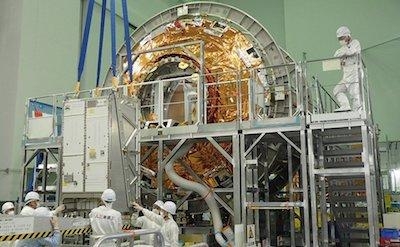Mon, Sep 10, 2018
Alexander Gerst To Install ESA´s New Technology Demonstrator On The ISS
Airbus is sending a new Life Support Rack to the International Space Station (ISS). The rack also known as Advanced Closed Loop System (ACLS) has been developed by Airbus for the ESA as a technology demonstrator, which will purify air and produce oxygen for the ISS.

The Life Support Rack is stored in the pressurized part of the Japanese HTV-7, an unmanned cargo spacecraft to resupply the ISS, which is currently set to launch from Tanegashima Space Center on 11 September 2018. It will be installed into the Destiny Module (U.S. Laboratory) by ESA astronaut and ISS commander Alexander Gerst on 2 November 2018. Its technology is a critical step forward towards a closed loop life support system, necessary for human spaceflight beyond low Earth orbit.
Air on the ISS has a higher carbon dioxide content than on Earth, in the order of 0.4 percent. ACLS will provide additional capacity to the existing ISS life support system to remove carbon dioxide from the cabin air. This is performed by two components: CO2 adsorption using Astrine (a solid amine resin), and use of a Sabatier reactor (using hydrogen to convert carbon dioxide into methane and water).
The third component of ESA´s new Rack is its electrolyser, which produces oxygen and hydrogen from water. The oxygen produced is used to replenish the cabin air, and the hydrogen is consumed by the Sabatier reactor.
A newly formed ACLS operations team (OPS), based at Airbus in Friedrichshafen, Germany, will operate the ACLS throughout its mission. ACLS OPS is part of the ISS’s ground network, and works directly with the ESA Columbus Control Center in Oberpfaffenhofen, Germany.
Following installation, the ACLS OPS team will commence a six week commissioning phase to check the new facility. Successful commissioning will be followed by operations on the ISS until the end of 2019, with the ACLS providing additional carbon dioxide removal and oxygen generation capabilities to the astronauts onboard.
(Image provided with Airbus news release)
More News
Aero Linx: JAARS Nearly 1.5 billion people, using more than 5,500 languages, do not have a full Bible in their first language. Many of these people live in the most remote parts of>[...]
'Airplane Bounced Twice On The Grass Runway, Resulting In The Nose Wheel Separating From The Airplane...' Analysis: The pilot reported, “upon touchdown, the plane jumped back>[...]
"Burt is best known to the public for his historic designs of SpaceShipOne, Voyager, and GlobalFlyer, but for EAA members and aviation aficionados, his unique concepts began more t>[...]
"Polaris Dawn, the first of the program’s three human spaceflight missions, is targeted to launch to orbit no earlier than summer 2024. During the five-day mission, the crew >[...]
There Are SO Many Ways To Get YOUR Aero-News! It’s been a while since we have reminded everyone about all the ways we offer your daily dose of aviation news on-the-go...so he>[...]
 ANN's Daily Aero-Linx (05.04.24)
ANN's Daily Aero-Linx (05.04.24) NTSB Final Report: Quest Aircraft Co Inc Kodiak 100
NTSB Final Report: Quest Aircraft Co Inc Kodiak 100 Aero-News: Quote of the Day (05.04.24)
Aero-News: Quote of the Day (05.04.24) Aero-News: Quote of the Day (05.05.24)
Aero-News: Quote of the Day (05.05.24) Read/Watch/Listen... ANN Does It All
Read/Watch/Listen... ANN Does It All



